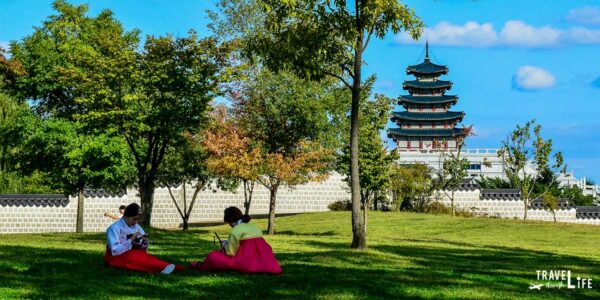It’s so hard to miss yet difficult to get in and out quickly to do those other things one has planned. That’s especially the case at Seoul’s Gyeongbokgung Palace. One of my biggest frustrations with the country is that everyone wants to visit the hotspots at the same time in Korea. Unless you’re a tourist or Seoullite lucky enough to visit on a weekday, waiting in line just to buy tickets to enter Gyeongbokgung Palace will take more than a moment. That’s saying something in Korea, when lines generally move fast!
Walking Around Gyeongbokgung Palace in Seoul
The queues and long waits make sense. I mean, Gyeongbokgung stands in the heart of so much in a place where roughly 50% of the country lives. There’s Mt. Bugak and the Seoul City Wall behind it. The Korean Presidential Blue House is close as well. Walking in the traditionally themed Gyeongbokgung Station presents an entrance that charges up one’s anticipation in case it isn’t yet brewing.
It’s more intriguing , however, to walk through Gwanghwamun Square in front of the palace. Here, passersby will come face to face with protestors that characterize the vocal and politically-charged spirit found throughout Korea. When visiting during a 3-day weekend in October, a walk through a Sewol Family hunger strike opened up wounds and reminders of that horrible tragedy that gripped country in April 2014.
Controversial moments happen right in front of Gyeongbokgung but the inside is what people come to see, and its vastness is hardly possible to encapsulate. Gyeongbokgung is huge, worthy of the thousands who descend upon it each day.
Walking inside gives one a look into a time before Korea was a modern nation state. After all, the Joseon Dynasty was the last ruler Koreans knew before Japan stole the show for a brief yet brutal time as colonizer. Gyeongbokgung is the last remnants of an era long forgotten, but what a reminder it is!
This is traditional Korea in its heyday, excessive and opulent as the grounds may come off to outsiders. The buck (or won) stopped at Gyeongbokgung for roughly 500 years, longer than most modern nations have existed. That means something, even if memories of the past are fading. And that must be why they come.
To take it all in, before going back out into that urban wilderness where the weak get eaten up and the strong survive to live as long as their hearts can keep up. Where bosses demand 150% and even that’s not good enough, but all that’s forgotten at Gyeongbokgung. This is a place where one can forget the chaotic present and uncertain future, to have a look at Korea’s past without regret. At Gyeongbokgung, they can turn it back.
This travel guide is part of our series on South Korea Travel and East Asia Travel. It was originally created on October 31, 2014. It has been maintained and updated (as of December 28, 2018) to reflect current viewpoints and travel trends.


Very thoughtful and well-written post. I think some people aren’t as moved by historic sites as others. Some people go to see pretty buildings, but I’ve always gotten wrapped up in the history and picturing everything that might have happened in those walls so long ago. I loved this post and I love your photos too! I just went to Gyeongbokgung over Seollal (it was also free then) and I’m sad to say my photos pale in comparison. Keep up the good work!
Christina thanks you for your comments. She usually has the right eye on things, as I tend to look only at landscapes and walkways. It’s good to know there are more people out there who prefer the backstory as opposed to the glamour that we all can easily see. I appreciate you stopping by and leaving such a thoughtful comment. Take care.
Nearly every time we revisit Seoul, we revisit Gyeongbokgung. The Changing of the Guards, the palace grounds, and the occasional performance of the King’s Feast never cease to amaze. Great post and great photos, as always.
Thanks so much for your kind comments. I truly appreciate them. Gyeongbokgung is certainly full of activity, huh? I’ve never witnessed the changing of the guards, though I bet that’s pretty cool to see. Have a link to a post about it?
We don’t have one about the changing of the guards, but we do have one about the King’s Banquet. They usually have it in May sometime, but the dates have always been subject to change. We went 2 years ago during the Lantern Festival for Buddha’s birthday. It was absolutely incredible.
https://hedgersabroad.wordpress.com/2014/08/04/gyeongbokgung-seouls-largest-palace/
Nice! I’ll check it out! Thanks.
A solid piece; your photos are majestic and your writing is tight. On a recent trip to the palace, I was one of the souls stuck in long queues and personal space was not an option. You’re so right, everyone heads to these hotspot places at the same time. Didn’t know the Blue House was so close! Will head there next time. Anyway, as mentioned, your writing is great. It’s descriptive, informative and I’m left wanting to explore more of your site AND the places you talk about. Nice one ^^
Thank you so much for your nice comment. I really hope you enjoyed the read. Have you visited Gyeongbokgung a lot? I keep wanting to go back, for some reason.
Stunning photos!!! I love to see some great photography nestled in a well-written post. I visited the palace during Chuseok last year and since all the palaces were open (and free to the public), I luckily avoided the queues–though the crowds were crazy! Thanks very much for teaching me a bit about the history–I’m looking forward to going back and doing a ‘palace weekend’ now that the weather is getting nicer!!
Thank you Lindsay! I am happy to hear you had no troubles during the holiday. I think that’s about the best time to visit Seoul, as everyone has gone to their hometowns away from the city. Could be wrong though. Did you write a post about Gyeongbokgung? Feel free to share if so!
What was the family protesting when they went on a hunger strike? I arrived a month later here in Daegu and was oblivious on the current news at the time. I do remember the most known news worthy story was the boat that sank and they had hundreds of casualities.
Photos look great! You’re writing is good and concise. Not sure if I’m a good judge for writing. I do love to read, but I’m no English major. I’ve been on your site before and enjoy reading about you adventures. Keep up the good job!
Hi Charisse, the families were protesting because of the Sewol accident which happened in 2014. I’m not sure if they are still there but they were at Gwanghwamun Square for quite some time, with some actively hunger striking many months after the accident. Were you in Korea at the time of the accident?
Thank you for the comment and compliments. I certainly appreciate them.